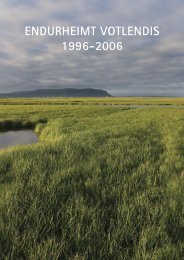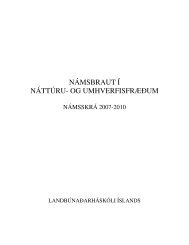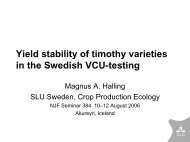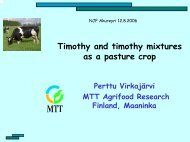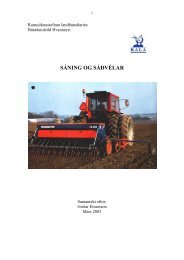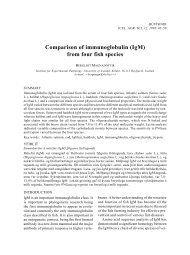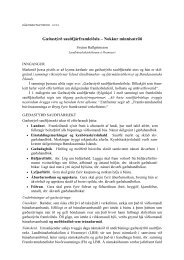Timothy â the saviour of Icelandic agriculture?
Timothy â the saviour of Icelandic agriculture?
Timothy â the saviour of Icelandic agriculture?
Create successful ePaper yourself
Turn your PDF publications into a flip-book with our unique Google optimized e-Paper software.
<strong>Timothy</strong><br />
- <strong>the</strong> <strong>saviour</strong> <strong>of</strong> <strong>Icelandic</strong> <strong>agriculture</strong><br />
Áslaug Helgadóttir and<br />
Þóroddur Sveinsson<br />
The Agricultural University <strong>of</strong> Iceland
Why timothy<br />
• Today timothy is <strong>the</strong> most important<br />
forage grass in <strong>Icelandic</strong> <strong>agriculture</strong>:<br />
– Yielding ability<br />
– Feed quality<br />
– Palatability<br />
– Persistence<br />
• But what has been its role in <strong>the</strong><br />
development <strong>of</strong> agricultural production<br />
1900-2005
Agriculture in a historical light<br />
Cattle<br />
Sheep<br />
250<br />
200<br />
150<br />
100<br />
50<br />
0<br />
1900 1925 1950 1975 2000<br />
Relative changes in cattle and sheep production from 1901-2003.<br />
Volume index 1945=100.
Agriculture in a historical light<br />
I. 900-1900:<br />
Self sufficiency<br />
II. 1900-1945:<br />
Cultivation begins<br />
III. 1945-1980:<br />
Technological advances,<br />
Increased prodcution<br />
IV. 1980-1995:<br />
Prodcution restrictions<br />
V. 1995-2006<br />
Improved efficiency<br />
Cattle Sheep<br />
250<br />
200<br />
150<br />
100<br />
50<br />
0<br />
1900 1920 1940 1960 1980 2000
Self sufficiency<br />
900-1900<br />
• Sheep husbandry was <strong>the</strong> main farming<br />
activity.<br />
• Hay was obtained from wild pastures and<br />
bog lands.<br />
• The country could carry 360,000 sheep.<br />
• This was sufficient to maintain a<br />
population <strong>of</strong> 60,000.
Cultivation begins<br />
1900-1945<br />
• Urban market for<br />
agricultural products.<br />
• Food security main<br />
political driver.<br />
• Farmers adopt new<br />
technology.<br />
• Artificial fertilisers<br />
taken into use.<br />
Cattle Sheep<br />
250<br />
200<br />
150<br />
100<br />
50<br />
0<br />
1900 1920 1940 1960 1980 2000
Technological advances,<br />
increased production<br />
1945-1980<br />
• Subsidy system<br />
rewards increased<br />
production.<br />
• Machinery imported<br />
to reclaim new<br />
agricultural land.<br />
• Extensive cultivation<br />
<strong>of</strong> grass fields with<br />
imported grasses.<br />
• Intensive use <strong>of</strong><br />
artificial fertilisers<br />
and concentrates.<br />
Cattle Sheep<br />
250<br />
200<br />
150<br />
100<br />
50<br />
0<br />
1900 1920 1940 1960 1980 2000
Production restrictions<br />
1980-1995<br />
Cattle<br />
Sheep<br />
• No political will for<br />
continued subsidy.<br />
• Changing food habits.<br />
• Quota system<br />
introduced.<br />
• Production adjusted<br />
to local demand.<br />
250<br />
200<br />
150<br />
100<br />
50<br />
0<br />
1900 1920 1940 1960 1980 2000
Improved efficiency<br />
1995-2006<br />
• Maintain margins by<br />
reducing inputs and<br />
increase outputs.<br />
• No. <strong>of</strong> farms decline<br />
but each farm gets<br />
larger.<br />
• Alternative land uses.<br />
• Multifunctional<br />
<strong>agriculture</strong>.<br />
Cattle Sheep<br />
250<br />
200<br />
150<br />
100<br />
50<br />
0<br />
1900 1920 1940 1960 1980 2000
Cultivation <strong>of</strong> grass fields<br />
8000<br />
6000<br />
Ha<br />
4000<br />
2000<br />
0<br />
1920 1940 1960 1980 2000<br />
Year<br />
Annual cultivation <strong>of</strong> grass fields (<strong>of</strong>ficial state records 1921-1992<br />
and estimated from seed imports 1995-2005).
Cultivation <strong>of</strong> grass fields<br />
• Support to farmers for<br />
reclaiming new land<br />
for cultivation 1923.<br />
• Heavy machinery<br />
arrives after World<br />
War II.<br />
• Relcamation <strong>of</strong><br />
drained bogs to 1980.<br />
• Field renovation after<br />
1980.<br />
Ha<br />
8000<br />
6000<br />
4000<br />
2000<br />
0<br />
1920 1940 1960 1980 2000<br />
Year
<strong>Timothy</strong> in farmers’ fields<br />
• <strong>Timothy</strong> and meadow fox-tail dominated<br />
seed mixtures in <strong>the</strong> early years.<br />
– Grindstad (N) and Øt<strong>of</strong>te (DK) 1955<br />
– Engmo (1962); Korpa (1970); Adda (1982)<br />
• <strong>Timothy</strong> made up 40-60% <strong>of</strong> <strong>the</strong> total area<br />
sown 1971-1990.
Persistence <strong>of</strong> timothy<br />
% cover<br />
70<br />
60<br />
50<br />
40<br />
30<br />
20<br />
10<br />
0<br />
Yr 1 Yr 2-5 Yr 6-10 Yr 11-20 Yr 21-30 >30 yrs<br />
Years from sowing<br />
From Thorvaldsson (1994)
Factors affecting persistence <strong>of</strong><br />
timothy<br />
• Geographic location<br />
• Moisture content<br />
• Degree <strong>of</strong> winter damage<br />
• Management<br />
– Harvest regime<br />
– Fertiliser treatment<br />
– Mixture companions
Period <strong>of</strong> improved efficiency from 1995<br />
• Increased demand for processed milk products.<br />
• Reduction in <strong>the</strong> number <strong>of</strong> dairy farms.<br />
• Dairy farms have been increasing in size.<br />
• Increase in milk production per animal:<br />
Milk l cow -1 yr -1<br />
5500<br />
4500<br />
3500<br />
2500<br />
1970 1980 1990 2000 2010<br />
Year
Period <strong>of</strong> improved efficiency from 1995<br />
• Substantial increase in <strong>the</strong> cultivation <strong>of</strong> grass<br />
fields <strong>of</strong> which timothy has made up 75-80 % <strong>of</strong><br />
<strong>the</strong> total area sown:<br />
8000<br />
6000<br />
Ha<br />
4000<br />
2000<br />
0<br />
1920 1940 1960 1980 2000<br />
Year
Has timothy contributed to <strong>the</strong><br />
recent advances in milk production
Reasons for improved efficiency<br />
• Improved quality <strong>of</strong> hay and silage.<br />
• Increased barley production<br />
• Genetic gains in <strong>the</strong> local cattle<br />
population.
Improved quality <strong>of</strong> roughages<br />
720<br />
700<br />
DMD, g kg -1 DM<br />
680<br />
660<br />
640<br />
620<br />
600<br />
580<br />
1975 1985 1995 2005<br />
Mean DMD <strong>of</strong> hay and silage samples from farms in NE-Iceland.
Improved quality <strong>of</strong> roughages<br />
• Earlier harvest <strong>of</strong> primary growth resulting from<br />
<strong>the</strong> uptake <strong>of</strong> wilted round bale silage in <strong>the</strong><br />
1980’s.<br />
• Growing importance <strong>of</strong> timothy after 1995.<br />
– Has made up 75-85% <strong>of</strong> total area sown with<br />
forage grasses.<br />
– Higher DMD compared to a mixture <strong>of</strong><br />
indigenous grasses (726 vs. 679 g kg-1).<br />
– Superior palatability and daily volunatry DM<br />
intake.
Increased barley production<br />
4000<br />
3000<br />
2000<br />
1000<br />
0<br />
‘91 ‘95 ‘00 ‘05<br />
Year<br />
Annual cultivation <strong>of</strong> barley from 1991-2005.
Barley cultivation calls for<br />
systematic crop rotation<br />
Has been<br />
Could be
Systematic crop rotation gives<br />
more fodder <strong>of</strong> better quality<br />
Feed units, million<br />
300<br />
250<br />
200<br />
150<br />
100<br />
50<br />
0<br />
Has been<br />
Could be<br />
Here, timothy plays a major role.
Unconventional uses <strong>of</strong> timothy<br />
• Horse breeding for pleasure riding is now<br />
a significant part <strong>of</strong> <strong>Icelandic</strong> <strong>agriculture</strong>.<br />
• The urban horse population is large and<br />
demands quality feed.
Unconventional uses <strong>of</strong> timothy<br />
<strong>Timothy</strong> cut 2-3 wks after heading and made<br />
into wilted silage fulfils <strong>the</strong> energy and<br />
protein requirements <strong>of</strong> active riding horses<br />
(Ragnarsson, 2004).
Conclusions<br />
• <strong>Timothy</strong> was not an option for farmers until 1970<br />
when winter hardy cultivars came on <strong>the</strong> market.<br />
• Its superior yield and quality was not exploited<br />
fully as persistence was poor and fields were<br />
rarely reneovated.<br />
• Recentemphasisoncroprotationallowsfarmers<br />
to enjoy <strong>the</strong> benefits <strong>of</strong> timothy.<br />
• <strong>Timothy</strong> has without doubt played a big role in<br />
<strong>the</strong> recent advances in milk production obtained<br />
over <strong>the</strong> last decade.



